crash sensor AUDI A8 2011 Owners Manual
[x] Cancel search | Manufacturer: AUDI, Model Year: 2011, Model line: A8, Model: AUDI A8 2011Pages: 302, PDF Size: 76.07 MB
Page 34 of 302

32 Opening and clos ing
-When closing a door, make sure noth
ing can interfere w ith the door. This
could cause ser ious personal injury.
- You can stop the door from closing at
any time by pulling on the inside or
outside door handle.
(D Tips
- In the event of a crash with airbag de
ployment all locked doors will be auto
matically unlocked to give access to the
vehicle occupants from the outside.
- If the power locking system should ma l
function, you can lock the dr iver's door
using the mechanical key¢
page 35 .
-If the power lock ing system should fail,
you can st ill open the fuel tank flap in an
emergency ¢
page 221.
-You are well advised not to keep valua
bles inside an unattended vehicle, visib le
or not . Even a properly locked vehicle
ca nnot provide the sec urity of a safe .
- If the LED in the upper edge of the driv er's door panel comes on for abo ut 30
seconds after t he vehi cle is locked, there
i s a ma lf u nction in the power loc king or
t h e anti- theft warni ng sys tem. Have the
malfunction corrected by an authorized
A udi dealersh ip or q ua lified repair facili
ty .
Setting power locking
The driver can determine the functions for
power locking in the MMI.
,.. Se lect : I CAR I fu nction button > Car sy ste m s
control button > Vehicle setting s > Central
locking .
Unl ock door s -
You can decide if All doors or
on ly the
Driver should unlock . The rear lid al
so unlocks when
All is se lected. If you select
Dri ver in a vehicle with a convenience key *,
only the door whose handle you pull will un
l ock. If you se
lect
Dri ver , all the doors and rear lid
will unlock if you press them button on the re
mote control maste r key twice.
Loc k exterior trunk handle -If you se lec t On ,
the rear lid handle is locked . In this case the
rear lid can be opened with the b utton
cs on
the master key or with the
cs button * in the
driver's door . In veh icles with a convenience
key* , you can still open the rear lid using the
handle if an authorized master key is near the
proxim ity sensor .
Fold mir rors * -If you select On , the exterior
rearview mirrors fold in automatically w hen
you press the
ffi button on the remote control
master key or touch the sensor* in the ha ndle.
Lock when dr iving -If you select On, the vehi
cle locks automatically when driv ing. All of
the doors and rear lid lock .
Tone when locking -When you select On , a
confirmat ion tone sounds when you lock the
vehicle.
Locking and unlocking the vehicle with
the remote control
Fig . 18 Re mote co ntrol : f u nct ion buttons
Either the driver's door o nly or the entire vehi
cle w ill unlock when the unlock button mis
pressed once, depending on the settings in
the MMI
r=;,page32 .
.,. Press button 0 to unlock the vehicle
¢fig. 18.
,.. Press button ffi to lock the vehicle ¢ .& in
General description on page 31 .
,.. Press button cs briefly to un lock the rear
lid.
Page 36 of 302

34 Opening and clo sing
@ Tips
If your vehicle has been standing for an ex
tended period, please note the following:
- The proximity sensors are deactivated af-
ter a few days to save power. You then
have to pull on the door handle once to
unlock the vehicle and a second time to
open the vehicle.
- To prevent the battery from being dis
charged and to preserve your vehicle's
ability to start for as long as possible,
the ene rgy management system gradu
ally switches off unnecessary conven i ence fun ct ions.
It is possible that you
will not be able to unlock your vehicle us
i ng these conven ience f unctions.
- For Declarat ion of Compliance to United
States FCC and Indus try Canada regul a
tions¢
page 286.
Operating locks with the key
In the event of a failure of the power locking system, the driver's door con be locked and
unlocked at the lock cylinder.
Fig. 2 0 Key turns for opening and closing .
.. Remove the mechanical key¢ page 30.
.. Turn the key to the left to unlock the driver 's
door .
.. Turn the key to the r ight to lock the driver's
doo r¢
/1. .
_& WARNING
Read and follow all WARNINGS r:::;, & in
General description on page 31.
Locking and unlocking the vehicle from
inside
Fig. 21 Drive r's door; power lock ing switch
Fi g. 22 Rear power locking switch
.. Press the button@ to lock the vehicle¢ /1..
.. Press the button al to unlock the vehicle
r:::;,ffg. 21, ¢ fig . 22 .
If you lock the vehicle using the power locking
switch, please note the followi ng:
- You cannot open the doors or the rear lid
from the
outside ( increased security, for ex
ample when you are stopped at a red light).
- The diodes in the power locking switches il-
luminate when all the doors are closed and
locked .
- You can un lock and open the doors from the
inside by pulling on the door handle .
- If you have a crash and the airbag is activat
ed, the doors automatically unlock.
_& WARNING
--The power lock ing switch works with the
ignit io n off and a utomat ica lly locks the
e ntire veh icle when it is actuated.
- On a vehicle locked from the outside the
power locking sys tem switch is inopera
tive.
Page 46 of 302
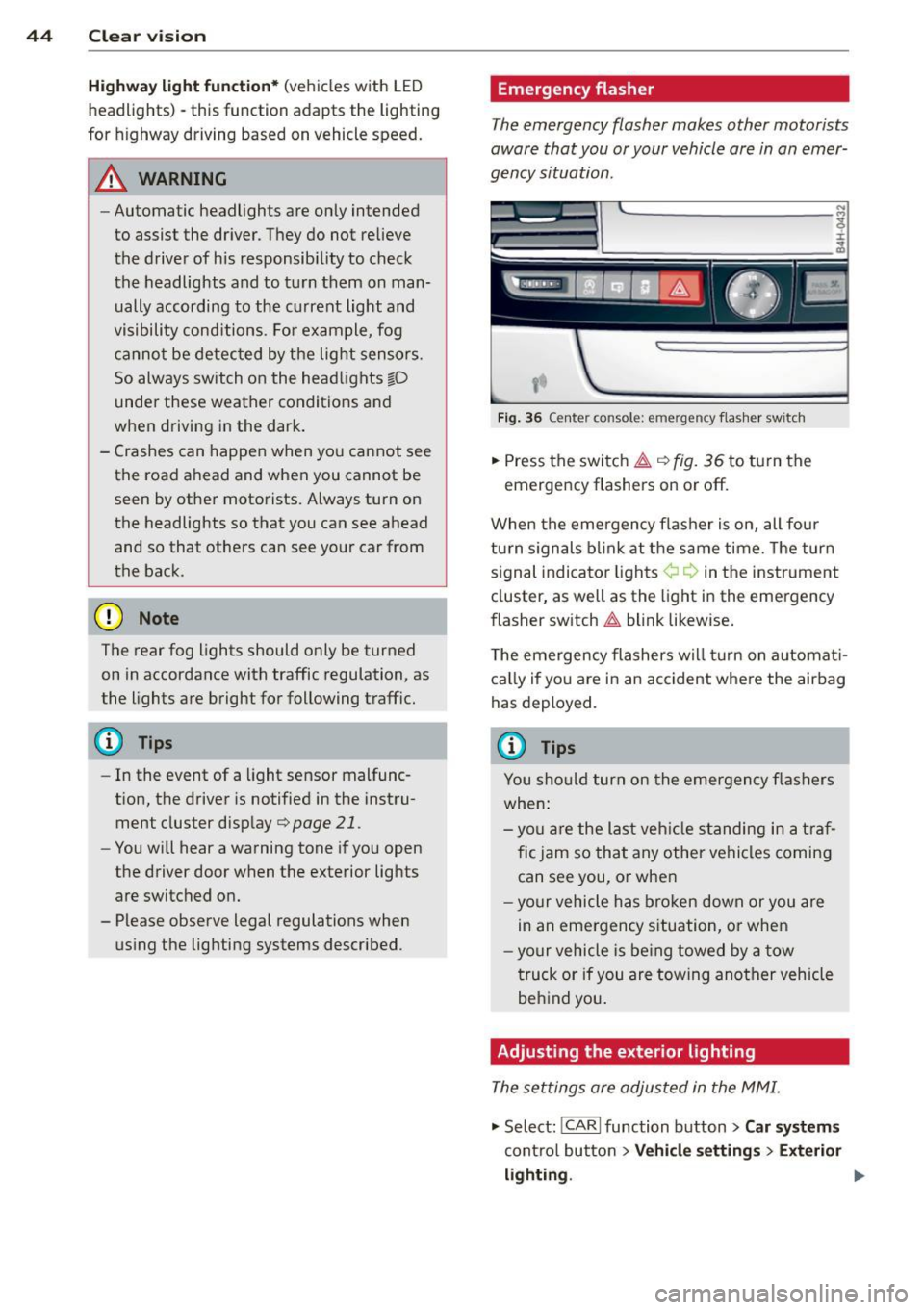
44 Clear vision
Highway light function*
(vehicles with LED
headlights) -this function adapts the lighting
for highway driving based on vehicle speed.
.&_ WARNING
- Automatic headlights are only intended
to assist the driver . They do not relieve
the driver of his responsibility to check the headlights and to turn them on man
ually according to the current light and
visibility conditions . For example, fog
cannot be detected by the light sensors.
So always switch on the headlights §,0
under these weather conditions and
when driving in the dark.
- Crashes can happen when you cannot see the road ahead and when you cannot be seen by other motorists. Always turn on
the headlights so that you can see ahead
and so that others can see your car from
the back .
(D Note
The rear fog lights should only be turned
on in accordance with traffic regulation, as
the lights are bright for following traffic.
(D Tips
- In the event of a light sensor malfunc
tion, the driver is notified in the instru
ment cluster display
q page 21 .
-You will hear a warning tone if you open
the driver door when the exterior lights
are switched on.
- Please observe legal regulations when
using the lighting systems described .
Emergency flasher
The emergency flasher makes other motorists
aware that you or your vehicle ore in on emer
gency situation .
Fig. 36 Ce nte r co nso le: em erg en cy flash er sw itch
.,. Press the switch~ c:> fig. 36 to turn the
emergency flashers on or off.
When the emergency flasher is on, all four
turn signals blink at the same time. The turn
signal indicator lights¢¢ in the instrument
cluster, as well as the light in the emergency
flasher switch
~ blink likewise.
The emergency flashers will turn on automati
cally if you are in an accident where the airbag
has deployed.
@ Tips
You should turn on the emergency flashers
when:
- you are the last vehicle standing in a traf
fic jam so that any other vehicles coming
can see you, or when
- your vehicle has broken down or you are
in an emergency situation, or when
-your vehicle is being towed by a tow
truck or if you are towing another vehicle
behind you.
Adjusting the exterior lighting
The settings ore adjusted in the MMI.
"'Select: !CARI function button> Car systems
control button > Vehicle settings > Exterior
lighting. ""
Page 154 of 302
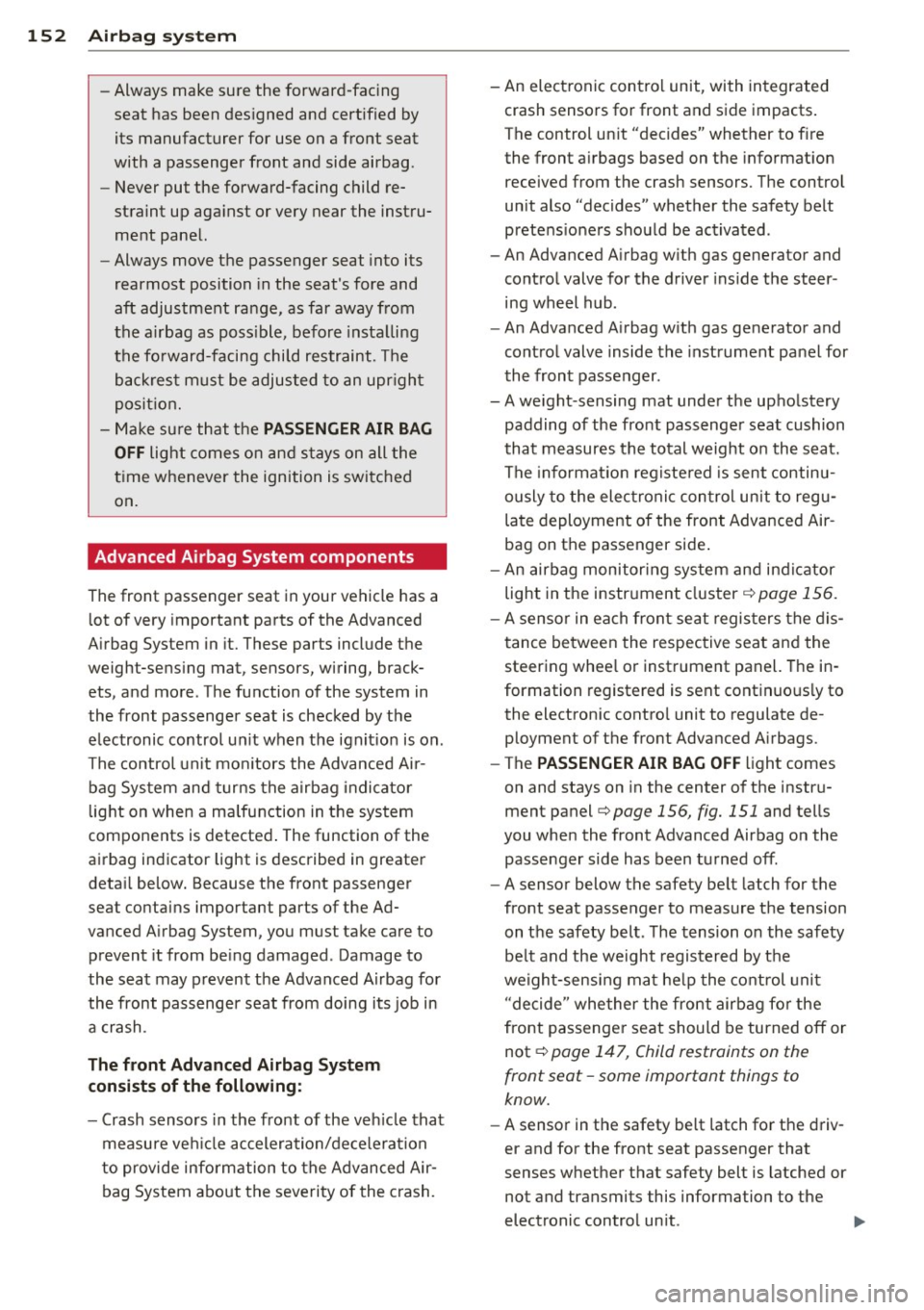
152 Airbag sys te m
- Always make su re the forward-facing
seat has been des igned and certified by
its manufacturer for use on a front seat
with a passenger front a nd side airbag .
- Never put the forward- facing child re
straint up against or very near the instru ment panel.
- Always move the passenger seat into its
rearmost position in the seat's fore and
aft adjustment range, as far away from
the a irbag as poss ible, before insta lli ng
the fo rward-facing chi ld restraint. The
b ackres t must be adjusted to an upr igh t
posit ion.
- Make su re that the
PASSENGER AIR BAG
OFF
light co m es on and s tays on all the
t ime whenever the ignition is switched
on.
Advanced Airbag System components
The front passenger seat in your vehicle has a lot of very important parts of the Advanced
Airbag System in it. These parts include the
weight-sens ing mat, sensors, wiring, brack
ets , and more . The function of the system in
the front passenger seat is checked by the
e lectronic control u nit when the ignit ion is on .
The control unit mo nitors the Advanced Air
bag Sys tem and turns the airbag indicator
light on when a ma lfunction in the system
components is detected . The function of the
ai rbag ind icator light is described in greater
detai l below. Because the front passenger
seat contains important parts of the Ad
vanced A irbag System, you must take care to
prevent it from be ing damaged . Damage to
the seat may prevent the Advanced A irbag for
the front passenger seat from doing its job in
a cra sh .
The front Advanced Airbag System
consists of the following:
- Crash senso rs in the front of the veh icle that
measu re ve hicle ac celera tion/de ce le ra ti on
to provide information to the Advanced Air bag System abo ut the severity of the crash . -
An elect ronic contro l unit, with integrated
crash sensors for front and side impacts .
The control un it "decides" whether to fi re
the front a irbags based on the informat ion
received from the crash sensors. The contro l
unit also "decides" whether the safety belt prete nsioners shou ld be act ivated .
- An Advanced A irbag w ith gas generator and
contro l valve for the driver ins ide the steer
ing wheel hub .
- An Advanced A irbag w ith gas generator and
contro l valve inside the instrument panel for
th e front passenger .
- A we ight-sensing mat under the upho lstery
padding of the fro nt passenge r seat cushion
that measures the total weight o n the seat.
The info rma tion reg iste red is sent continu
ously to the elec troni c con trol un it to regu
la te deployment o f the front Advanced Air
bag on the passenger side .
- An airbag monitor ing sys tem and indic ator
light in t he instr ument cluster ¢
page 15 6.
- A sensor in each front se at regis ters the dis
t ance between the respec tive seat and the
steering whee l o r instrument panel. The in
formation registered is sent continuo usly to
the electron ic contro l unit to regulate de
ployment of the front Adv a need A irbags .
- The
PASSENGER AIR BAG OFF light comes
on and stays on in the center of the instr u
ment panel¢
page 156, fig. 151 and tells
you whe n the front Advanced Airbag on the
passenger side has been turned off .
- A sensor below the safety be lt latch for the
front seat passe nger to measure the tension
on the safety be lt . The tension o n the safety
be lt and the we ight registered by t he
weigh t-sens ing ma t he lp the cont rol unit
" de cide " whe ther the fro nt airbag fo r the
front passenge r seat should be turned off or
not ~
page 147, Child restraints on the
front seat -some important things to
know.
- A sensor in the safety belt latch fo r the d riv
er and for the front seat passenger that
senses whether that safety belt is latched or not and transmits this information to the
electronic control un it .
Page 155 of 302
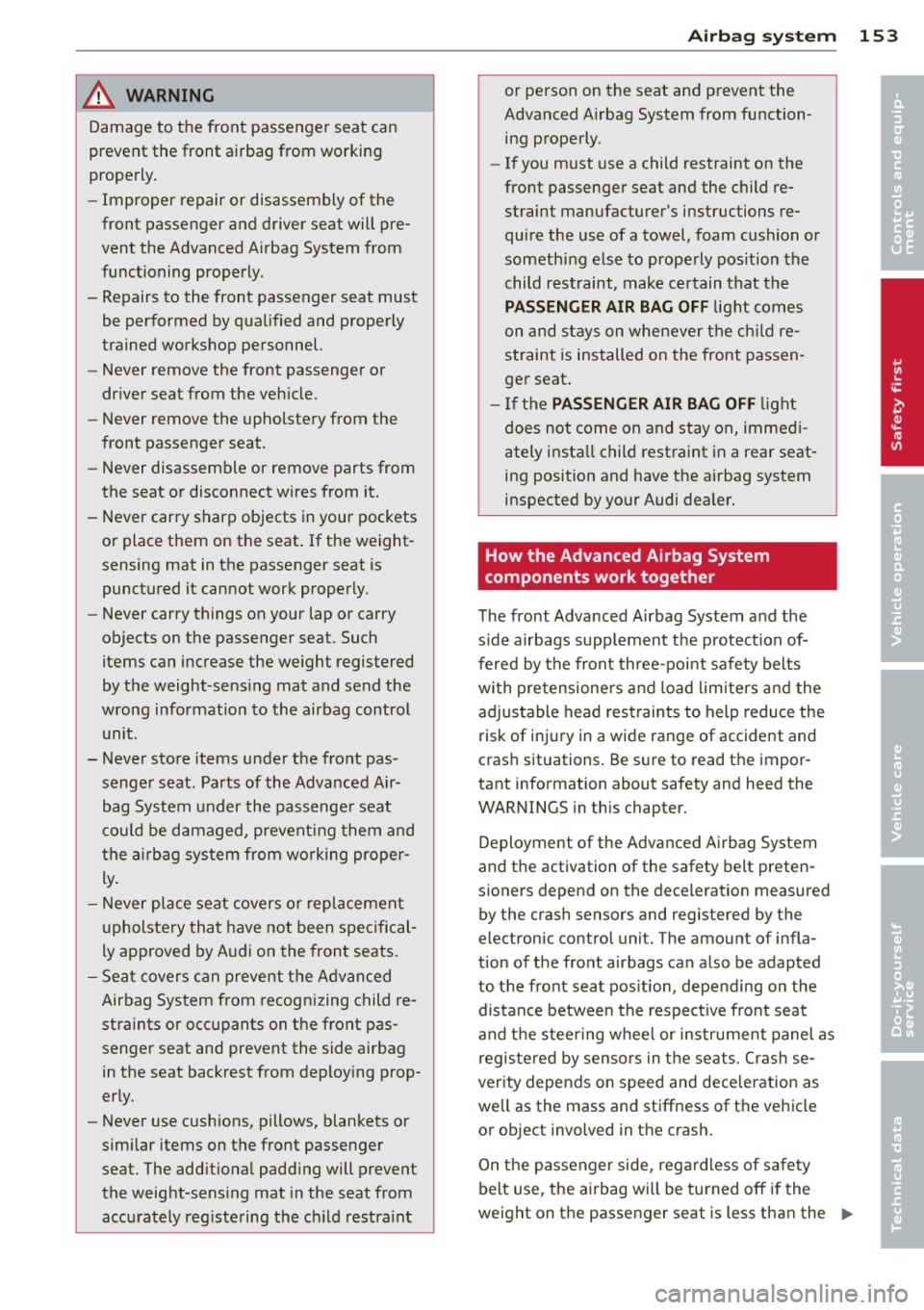
& WARNING
Damage to the front passenger seat can
prevent the front airbag from working
properly.
- Improper repair or disassembly of the
front passenger and driver seat will pre
vent the Advanced Airbag System from
functioning properly.
- Repairs to the front passenger seat must
be performed by qualified and properly
trained workshop personnel.
- Never remove the front passenger or
driver seat from the vehicle.
- Never remove the upholstery from the
front passenger seat.
- Never disassemble or remove parts from
the seat or disconnect wires from it.
- Never carry sharp objects in your pockets
or place them on the seat. If the weight
sensing mat in the passenger seat is
punctured it cannot work properly.
- Never carry things on your lap or carry
objects on the passenger seat. Such
items can increase the weight registered
by the weight-sensing mat and send the
wrong information to the airbag control
unit.
- Never store items under the front pas
senger seat. Parts of the Advanced Air
bag System under the passenger seat
could be damaged, preventing them and
the airbag system from working proper
ly.
- Never place seat covers or replacement
upholstery that have not been specifical
ly approved by Audi on the front seats.
- Seat covers can prevent the Advanced
Airbag System from recognizing child re straints or occupants on the front pas
senger seat and prevent the side airbag
in the seat backrest from deploying prop
erly.
- Never use cushions, pillows, blankets or
similar items on the front passenger
seat. The additional padding will prevent
the weight-sensing mat in the seat from
accurately registering the child restraint
-
Airbag system 153
or person on the seat and prevent the
Advanced Airbag System from function
ing properly.
- If you must use a child restraint on the
front passenger seat and the child re
straint manufacturer's instructions re
quire the use of a towel, foam cushion or
something else to properly position the
child restraint, make certain that the
PASSENGER AIR BAG OFF light comes
on and stays on whenever the child re
straint is installed on the front passen
ger seat.
- If the PASSENGER AIR BAG OFF light
does not come on and stay on, immedi
ately install child restraint in a rear seat
ing position and have the airbag system
inspected by your Audi dealer.
How the Advanced Airbag System
components work together
The front Advanced Airbag System and the
side airbags supplement the protection of
fered by the front three-point safety belts
with pretensioners and load limiters and the
adjustable head restraints to help reduce the
risk of injury in a wide range of accident and
crash situations. Be sure to read the impor
tant information about safety and heed the
WARNINGS in this chapter.
Deployment of the Adv a need Airbag System
and the activation of the safety belt preten
sioners depend on the deceleration measured by the crash sensors and registered by the
electronic control unit. The amount of infla
tion of the front airbags can also be adapted
to the front seat position, depending on the
distance between the respective front seat
and the steering wheel or instrument panel as registered by sensors in the seats. Crash se
verity depends on speed and deceleration as
well as the mass and stiffness of the vehicle
or object involved in the crash.
On the passenger side, regardless of safety
belt use, the airbag will be turned off if the
weight on the passenger seat is less than the
Iii>'
•
•
Page 158 of 302
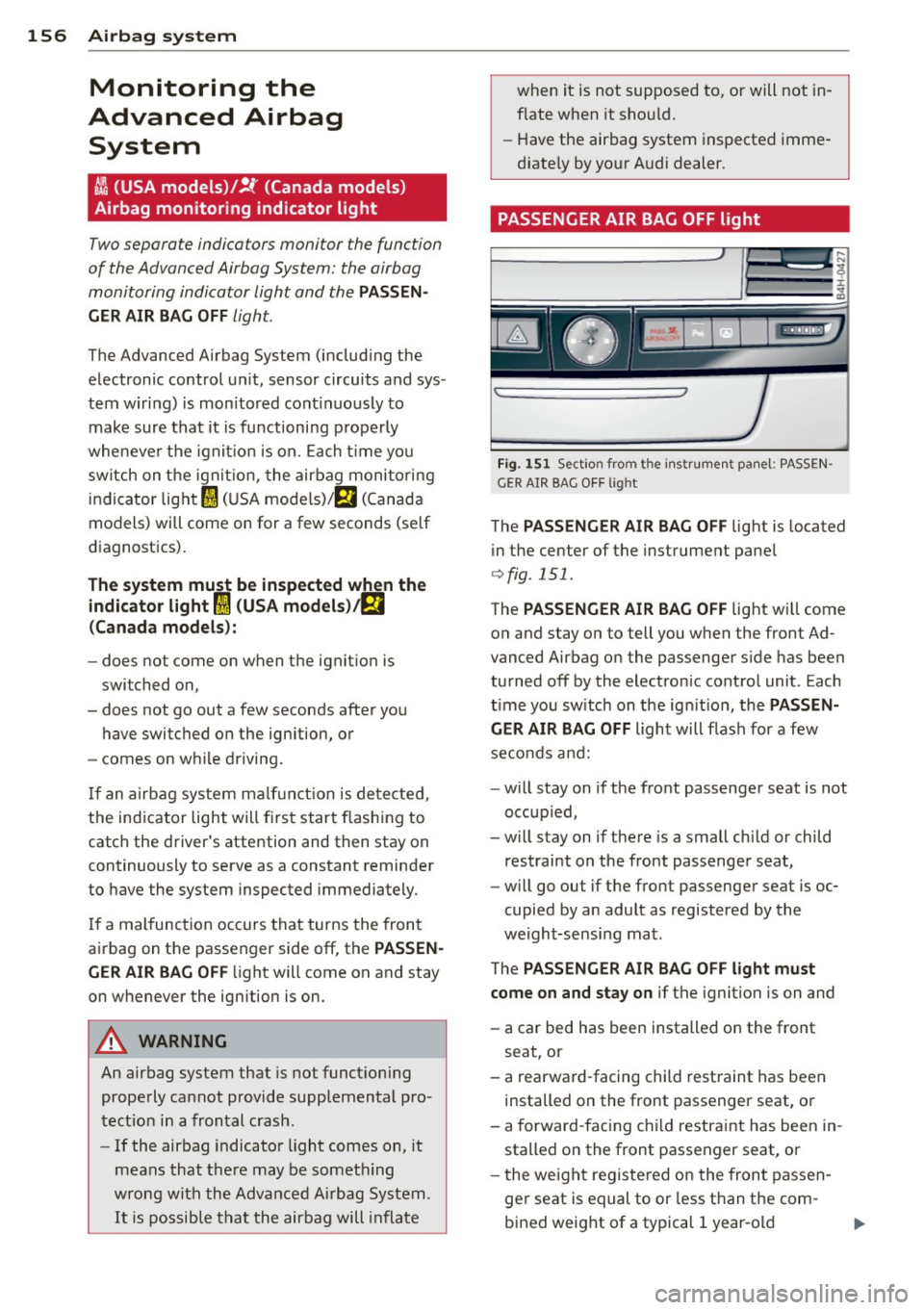
156 Airbag system
Monitoring the
Advanced Airbag
System
I (USA models)/!f (Canada models )
Airbag monitoring indicator light
Two separate indicators monitor the function
of the Advanced Airbag System: the airbag
monitoring indicator light and the
PASSEN
GER AIR BAG OFF
light.
The Advanced Airbag System (includ ing the
e lectronic control u nit, sensor circuits and sys
tem w iring) is mon itor ed cont inuo usly to
make sure that it is functioni ng p roperly
wheneve r the igni tion is on. Each time yo u
sw itch on t he ign it io n, the air bag moni to ring
indicator light
mJ ( U SA mode ls)/ m (C anada
models) will come on for a few seconds (se lf
d iagnost ics).
The system must be inspected when the
indicato r light
fl (USA models)/EJ
(Canada models ):
- does not come on when the ignit ion is
switched on,
- does not go out a few seconds afte r yo u
have switched on the ignition, or
- comes on while driving.
If an airbag sys tem malf unct ion is de te cte d,
the ind icator light will firs t start flash ing to
catch the driver's attention and then stay on
continuously to se rve as a constant reminder
to have the system inspected immediately .
If a mal function occurs that turns the fron t
a ir bag on t he passenger side
off, the PASSEN
GER AIR BAG OFF
li ght will come on and stay
on whenever the ignition is on.
A WARNING
An airbag system that is not funct ioning
prope rly ca nnot provide supplemental pro
t ect ion in a fron tal crash.
- If the airbag indicato r light comes on, it
means that t he re may be somet hing
wrong with the Advanc ed Ai rbag System .
It is possib le t hat the airbag will inflate
-
when it is not supposed to, or will not in
f late when it sho uld.
- Have the airbag system inspected imme
diate ly by yo ur Audi dealer.
PASSENGER AIR BAG OFF light
Fi g. 151 Sect io n fr om the instru men t pa nel: PASS EN ·
GER AIR BAG OFF lig ht
The PASSENGER AIR BAG OFF light is located
in the center of the instrument pane l
<=> fig. 151.
The PASSENGER AIR BAG OFF light wi ll come
on and stay on to tell you w hen the front Ad
vanced Airbag on the passenger s ide has been
turned
off by the electron ic contro l unit . Each
t ime you sw itch on the ig nition, the
PASSEN
GER AIR BAG OFF
light will flas h for a few
se conds a nd:
- will stay on if the fro nt passenger seat is not
occupied,
- will stay on if there is a small c hild or child
restrai nt on the front passenge r seat,
- will go out if the front passenger seat is oc
cupied by an adult as registered by the
weight-sensing ma t.
The
PASSENGER AIR BAG OFF light must
come on and stay on
if the ignition is on and
- a ca r bed has been installed on the front
seat, or
- a rearwa rd -facing child rest raint has been
installed o n the front passenger seat, o r
- a forwar d-fac ing ch ild restra int has been in
stalled on the front passenger seat , or
- t he weigh t reg iste red on the fron t passen
ge r seat is equal to or less t han the com-
bined weig ht of a typical 1 year -o ld .,..
Page 162 of 302

160 Airbag sys te m
regulations must be obse rved . Your au
thorized A udi dealer is familiar with these
req uirements and we recommend that you
have your dea ler perform this service for
you.
Other things that can affect Advanced
Airbag performance
Changing the vehicle's suspension system can
change the way that the Advanced Airbag Sys
tem performs in a crash. For example, using
tire-rim combinations not approved by Audi,
lowering the vehicle, changing the stiffness of
the suspension, including the springs, suspen
sion struts, shock absorbers etc. can change
the forces that are measured by the a irbag
sensors and sent to the electronic control un it . Some suspension changes can, for exam
p le, increase the force levels measured by the
sensors and make the airbag system deploy in
crashes in w hich it would not dep loy i f the
changes had not been made. Other kinds of
changes may reduce the force levels meas
ured by the sensors and prevent the airbag
from deploying when it should.
The sensors in the safety belt buckle fo r the
driver and front passenger seat tell the elec
tronic control module if the safety belt is
latched or not. If the safety belt is being used,
the front airbag will deploy at a slightly high
er rate of vehicle deceleration than if the safe
ty belt is not being used. Therefore, in a par
ticular co llision, it is poss ible that an a irbag
will not deploy at a seating position whe re the
safety be lt is being used but will inflate at the
position whe re the safety belt is not being
used . It is importan t that nothing interfe re
with the safety belt buckles so that the sen
sors can send the correct information abo ut
safety be lt use to the electron ic contro l unit.
A WARNING
Changing the vehicle 's suspension includ
ing use of unapproved tire-r im combina
tions can change Advanced Airbag pe r
formance and increase the risk of ser ious
personal in jury in a crash. -
Never install suspension components
that do not have the same performance
characteristics as the components origi
nally installed on your vehicle .
- Never use tire-rim combinations that
have not been approved by Audi.
A WARNING .....__ -
Items stored between the safety be lt
b uckle and the ce nter console can cause
the sensors in the buckle to send the
wrong information to the e lectronic con
trol module and prevent the Advanced Air
b ag System from working prope rly.
- Always ma ke sure that nothing can inter
fe re with the safety belt buckles and that
they are not obs truc ted.
@ For the sake of the environment
Undeployed airbag modules and p reten
s ione rs might be classified as Per chlorate
Materia l - specia l hand ling may apply, see
www.dtsc.ca.gov/ha zardouswaste/per
ch lorate. When the vehicle or parts of the
rest raint system including airbag modu les
and safety belts with pretensioners are
scrapped, all applicab le laws and regu la
tions must be observed. Your authorized
Audi dealer is familiar with these require ments and we recommend that you have
your dealer perform this service for you.
Page 197 of 302
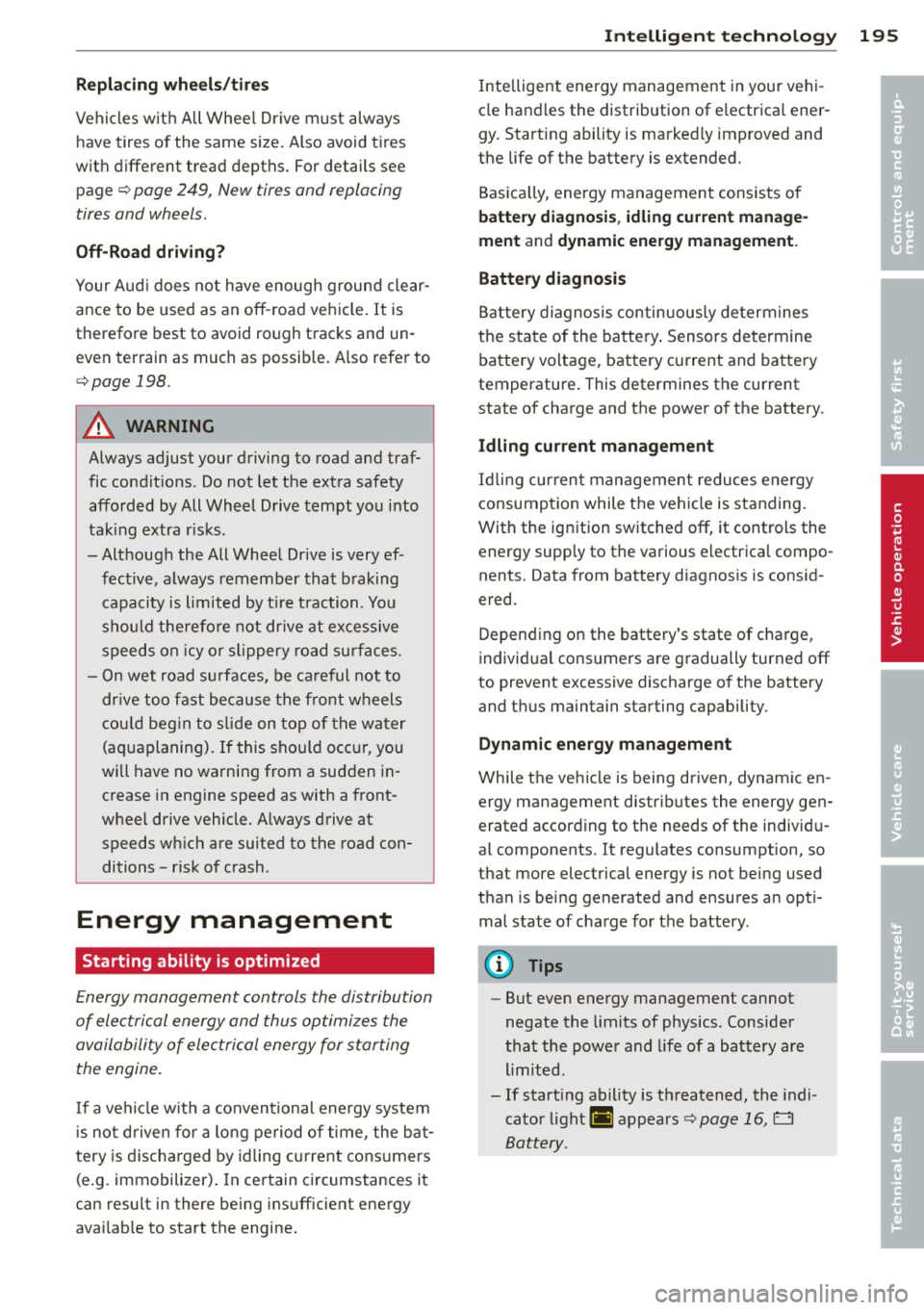
Replacing wh eels/ tire s
Vehicles w ith All Wheel Dr ive must always
have tir es of the same size. Also avoid tires
with different tread depths. For details see
pag e¢
page 249 , N ew tires and replacing
tires and wheels .
Off-Road driving?
Your Aud i does not have enough ground clear
ance to be used as an off -road vehicle. It is
therefor e best to avoid rough tracks and un
even terrain as much as possible . Also refer to
¢ page 198.
A WARNING
Always adjust your driving to road and traf
fic condit ions . Do not let the extra safety
afforded by All Wheel Drive tempt you into
taking extra risks.
- Although the All Wheel Drive is very ef
fective, always remember that braking
capacity is limited by t ire traction . Yo u
should the refore not dr ive at excessive
speeds on icy or s lippery road surfaces.
- On wet road su rfaces, be ca reful not to
dr ive too fast because the front wheels
cou ld beg in to s lide on top of the wa ter
(aquaplaning). If this sho uld occ ur, you
will have no warning from a sudden in
crease in engine speed as with a front
wheel drive vehicle. A lways drive at
speeds wh ich are suited to the road con
ditions -risk of crash .
Energy management
Starting ability is optimized
Energy management controls the distribution
of electrical energy and thus optimi zes the
availability of electrical energy for starting the engine.
If a vehicle wit h a conventional energy system
i s not driven for a long period of time , the bat
tery is discharged by idling cu rrent consumers
(e .g. immobilizer) . In certain circumstances it
can result in there being ins ufficient energy
avai lab le to start the engine.
Int ellig ent technolog y 195
Intelligent energy management in your vehi
cle hand les the distribution of e lectrica l ener
gy. Start ing ability is marked ly improved and
the life of the b attery is extended.
Bas ica lly, energy management consis ts of
batte ry diagnosi s, idling cur rent m anage
ment
and dynamic energ y management.
Battery diagnosis
Battery diagnosis continuously de termines
the state of the battery . Sensors de termine
batte ry voltage, battery current and battery
temperature . This determines the current
state of charge and the power of the batte ry .
Idling current management
Id lin g cur ren t management reduces energy
consumption while the vehicle is standing.
With the ig nition switched off, it controls the
energy supply to the various electrical compo nents. Data from battery diagnos is is cons id
ered.
Depend ing on the battery's state of cha rge ,
individua l cons umers are gradually turned off
to prevent excessive discharge of the batte ry
and th us maintain starting capability .
Dynamic energy manag ement
While the ve hicle is being driven, dynamic en
ergy management distrib utes the energy ge n
erated according to the needs of the individ u
al components . It regulates consumption, so
that more electrical energy is not being used
than is being generated and ensures an opti
mal state of charge for the battery .
@ Tips
-But even energy management cannot
negate the limits of physics. Consider
t hat the powe r and l ife of a battery are
limited.
- If start ing ability is threatened, the indi
cator light
(•i appears ¢ page 16, c:::3
Battery.
•
•